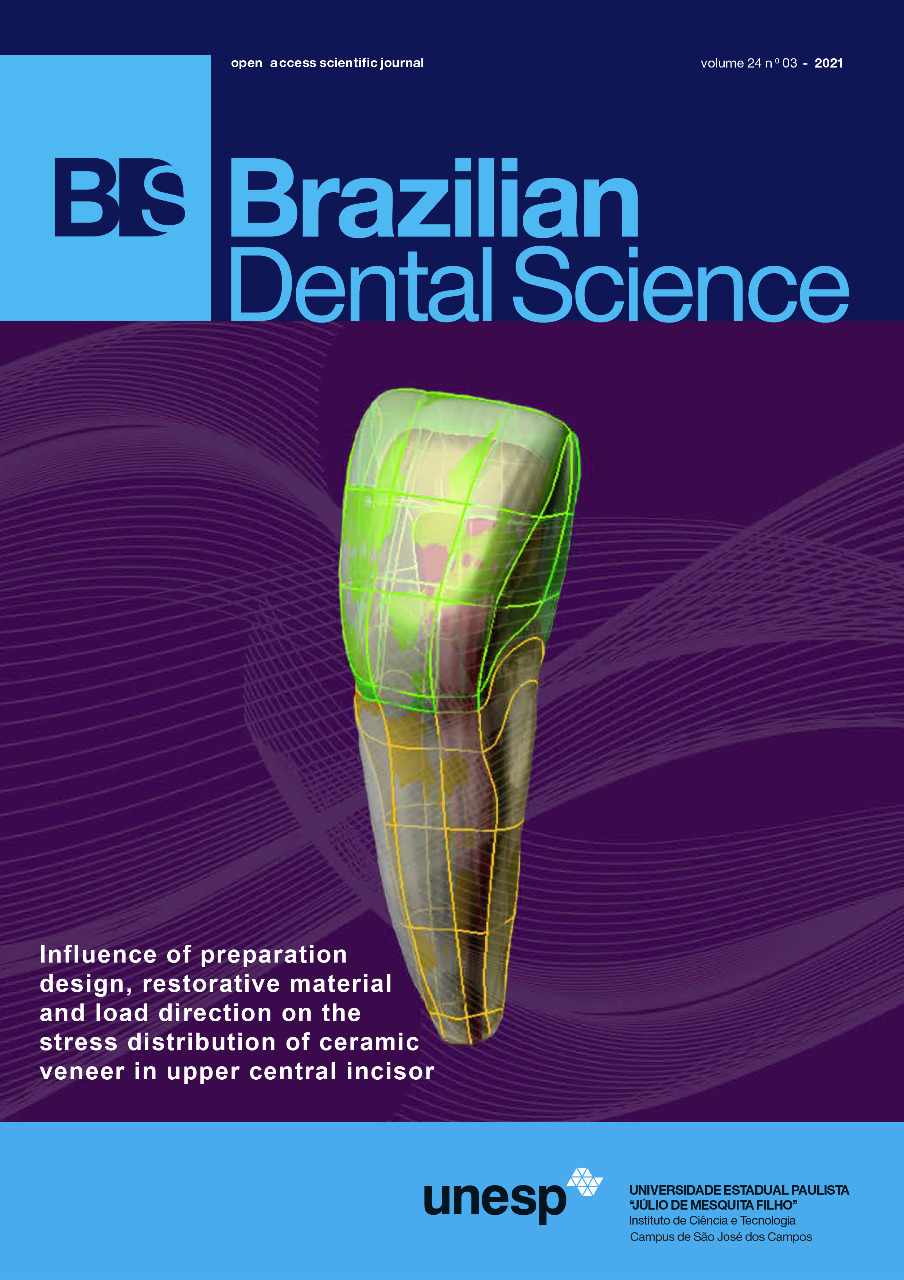The Effect of Different Surface Treatment Protocols on the Shear Bond Strength to Repressed Lithium Disilicate Glass Ceramics
DOI:
https://doi.org/10.14295/bds.2021.v24i3.2462Resumen
Objective: The present study aimed to evaluate the effect of repressing and different surface treatment protocols on the shear bond strength of lithium disilicate glass-ceramics. Material and Methods: A total of 52 lithium disilicate glass-ceramic discs (IPS emax Press, Ivoclar Vivadent) were fabricated using the heat-press technique. The discs were divided into two groups; group (P): discs fabricated from new e.max ingots (n=26), group (R): discs fabricated from reused e.max buttons (n=26). Each group was subdivided into subgroup (E): discs were etched with hydrofluoric acid (9.5%) (n=13), subgroup (S): discs were air-abraded with 110 µm alumina particles. All specimens were subjected to X-ray Diffraction analysis, Scanning Electron Microscope, Energy Dispersive X-Ray, Thermo-Cycling, and Shear Bond Strength Testing. Results: Repressed Etched subgroup (RE) recorded the statistically highest shear bond strength value, followed by the Pressed Etched subgroup (PE), while the statistically lowest shear bond strength value was recorded for the Pressed Air-Abraded subgroup (PS) and Repressed Air-Abraded subgroup (RS). Conclusion: Repressing the leftover buttons for the construction of new lithium disilicate glass-ceramic restorations has no adverse effect on the bond strength of the resin cement to the ceramic. Hydrofluoric acid surface treatment improves the shear bond strength and durability of resin cement bond to both pressed and repressed lithium disilicate glass-ceramic. Air-abrasion cannot be considered as a reliable surface treatment when bonding to lithium disilicate glass-ceramics.
Keywords
Heat pressed; Lithium disilicate glass-ceramics; Repressing; Shear bond strength; Surface treatment.
Descargas
Descargas
Publicado
Versiones
- 2021-07-01 (3)
- 2021-07-01 (2)
- 2021-07-01 (1)
Cómo citar
Número
Sección
Licencia
Brazilian Dental Science uses the Creative Commons (CC-BY 4.0) license, thus preserving the integrity of articles in an open access environment. The journal allows the author to retain publishing rights without restrictions.
=================
COPYRIGHT TRANSFER AND RESPONSIBILITY STATEMENT
(PDF)
For all articles published in the BDS journal, copyright is retained by the authors. Articles are licensed under an open-access Creative Commons CC BY 4.0 license, meaning that anyone may download and read the paper for free. In addition, the article may be reused and quoted, provided that the original published version is cited. These conditions allow for maximum use and exposure of the work while ensuring that the authors receive proper credit. All metadata associated with published articles is released under the Creative Commons CC0 Universal Public Domain Dedication.
Before the submission, authors must obtain permission to reproduce any published material (figures, schemes, tables, or any extract of a text) that does not fall into the public domain or for which they do not hold the copyright. Permission should be requested by the authors from the copyright holder (usually the Publisher, please refer to the imprint of the individual publications to identify the copyright holder).
The authors hereby attest that the study is original and does not present manipulated data, fraud, or plagiarism. All names listed made a significant scientific contribution to the study, are aware of the presented data, and agree with the final version of the manuscript. They assume complete responsibility for the ethical aspects of the study.
This text must be printed and signed by all authors. The scanned version should be submitted as supplemental file during the submission process.




























